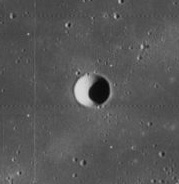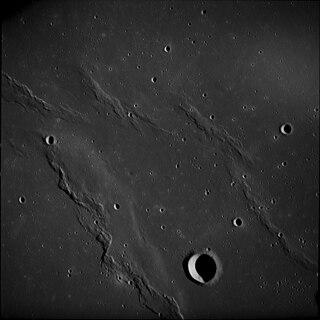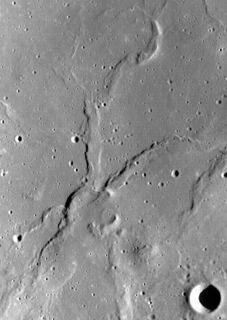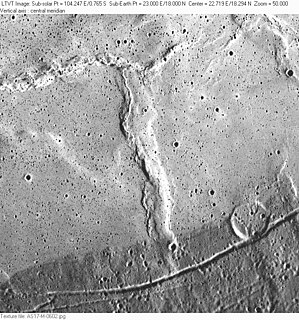
Humason is a tiny lunar impact crater located in the Oceanus Procellarum. This is a cup-shaped crater with an outer rim that rises slightly above the surrounding lunar mare. To the west is a low system of mare wrinkle ridges named the Dorsa Whiston that wind southwards towards Montes Agricola.

Zinner is a tiny lunar impact crater located due north of the crater Schiaparelli on the Oceanus Procellarum. It is circular and cup-shaped, with a high albedo in comparison to the surrounding lunar mare. The crater has essentially no rim because the mare lava nearly flooded it. A ray from the crater Glushko crosses Zinner. To the northwest is the slightly larger crater Golgi. East of Zinner is the Dorsa Burnet wrinkle ridge system.

Very is a small lunar impact crater located in the eastern part of Mare Serenitatis, to the west-southwest of Le Monnier. It lies upon a wrinkle ridge that runs to the north and south named Dorsa Smirnov. It was named after American astronomer Frank W. Very. The crater was previously known as Le Monnier B, a satellite crater of Le Monnier, before being renamed by the IAU in 1973.

A wrinkle ridge is a type of feature commonly found on lunar maria. These features are low, sinuous ridges formed on the mare surface that can extend for up to several hundred kilometers. Wrinkle ridges are tectonic features created when the basaltic lava cooled and contracted. They frequently outline ring structures buried within the mare, follow circular patterns outlining the mare, or intersect protruding peaks. They are sometimes called veins due to their resemblance to the veins that protrude from beneath the skin.

Cajal is a small lunar impact crater on the northern part of the Mare Tranquilitatis. It was named after the Spanish doctor and Nobel laureate Santiago Ramón y Cajal. It is a circular, cup-shaped formation that lies southeast of the lava-inundated crater Jansen. Cajal was formerly designated Jansen F. Also to the northwest is a system of wrinkle ridges designated the Dorsa Barlow.

Letronne is the lava-flooded remnant of a lunar impact crater. It was named after French archaeologist Jean-Antoine Letronne. The northern part of the rim is completely missing, and opens into the Oceanus Procellarum, forming a bay along the southwestern shore. The formation is located to the northwest of the large crater Gassendi.To the west-southwest is the flooded crater Billy, and north-northwest lies the smaller Flamsteed.

Atwood is a small earth moon impact crater that is located on the Mare Fecunditatis, to the northwest of the prominent crater Langrenus. It forms a triple-crater formation with Naonobu attached to the north rim and Bilharz near the west rim.

Webb is a small lunar impact crater that is located near the eastern edge of the Mare Fecunditatis, in the eastern part of the Moon near the equator. It was named after British astronomer Thomas William Webb. It is to the north of the prominent crater Langrenus, and west of Maclaurin.
Dorsa Aldrovandi is a wrinkle ridge system at 23.6°N 28.7°E in Mare Serenitatis on the Moon. It is about 127 km long and was named after the 16th century Italian naturalist Ulisse Aldrovandi. The north end of the feature is at the crater Le Monnier, and the south end is close to the craters Clerke and Abetti.

Dorsa Andrusov is a wrinkle ridge system at 1.0°S 57.0°E in Mare Fecunditatis on the Moon. It is 160 km in diameter and was named after Soviet geologist Nicolai Ivanovich Andrusov in 1976 by the IAU.

Dorsa Smirnov is a wrinkle ridge system at 27.3°N 25.3°E in eastern Mare Serenitatis on the Moon. It is 222 km long and was named after Soviet geologist Sergei Sergeevich Smirnov by the IAU in 1976.

Dorsa Burnet are wrinkle ridges at 28.4°N 57.0°W in Oceanus Procellarum on the Moon. They are about 194 km long and were named after Thomas Burnet by the IAU in 1976.

Dorsa Cato is a wrinkle ridge at 1.0°N 47.0°E on the Moon. It is approximately 130 km long and was named after the ancient Roman senator and historian Cato the Elder in 1976 by the IAU.

Dorsa Geikie is a wrinkle ridge at 4.6°S 52.5°E in Mare Fecunditatis on the Moon. It is approximately 220 km long and was named after Scottish geologist Sir Archibald Geikie in 1976 by the IAU.

Dorsum Cayeux is a wrinkle ridge at 1.6°N 51.2°E in Mare Fecunditatis on the Moon. It is approximately 95 km long and was named after French geologist Lucien Cayeux in 1976 by the IAU.

Dorsum Nicol is a wrinkle ridge on the Moon at 18.0°N 23.0°E in Mare Serenitatis near the border of Mare Tranquilitatis. It is 44 km long and was named after Scottish physicist William Nicol in 1976.















